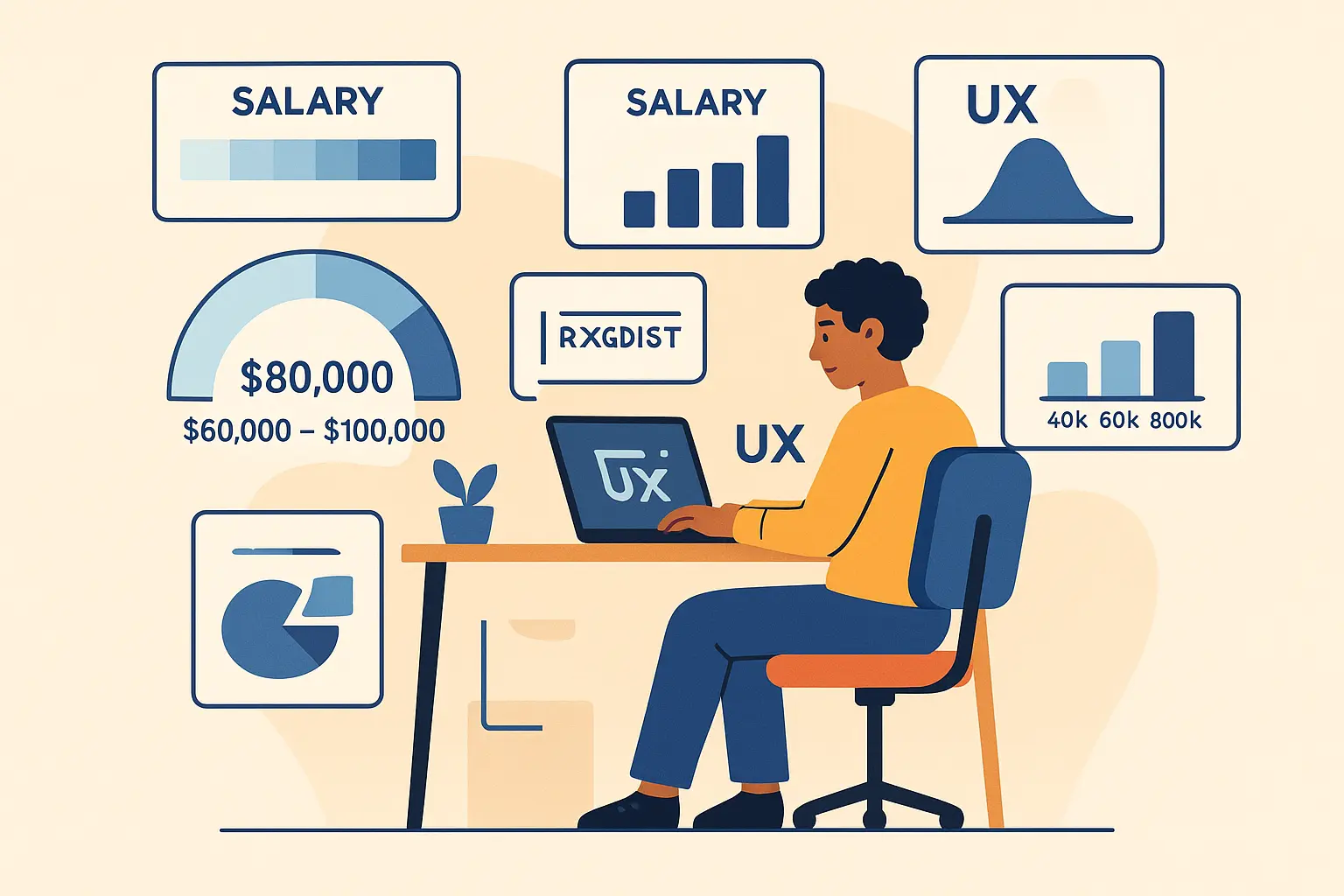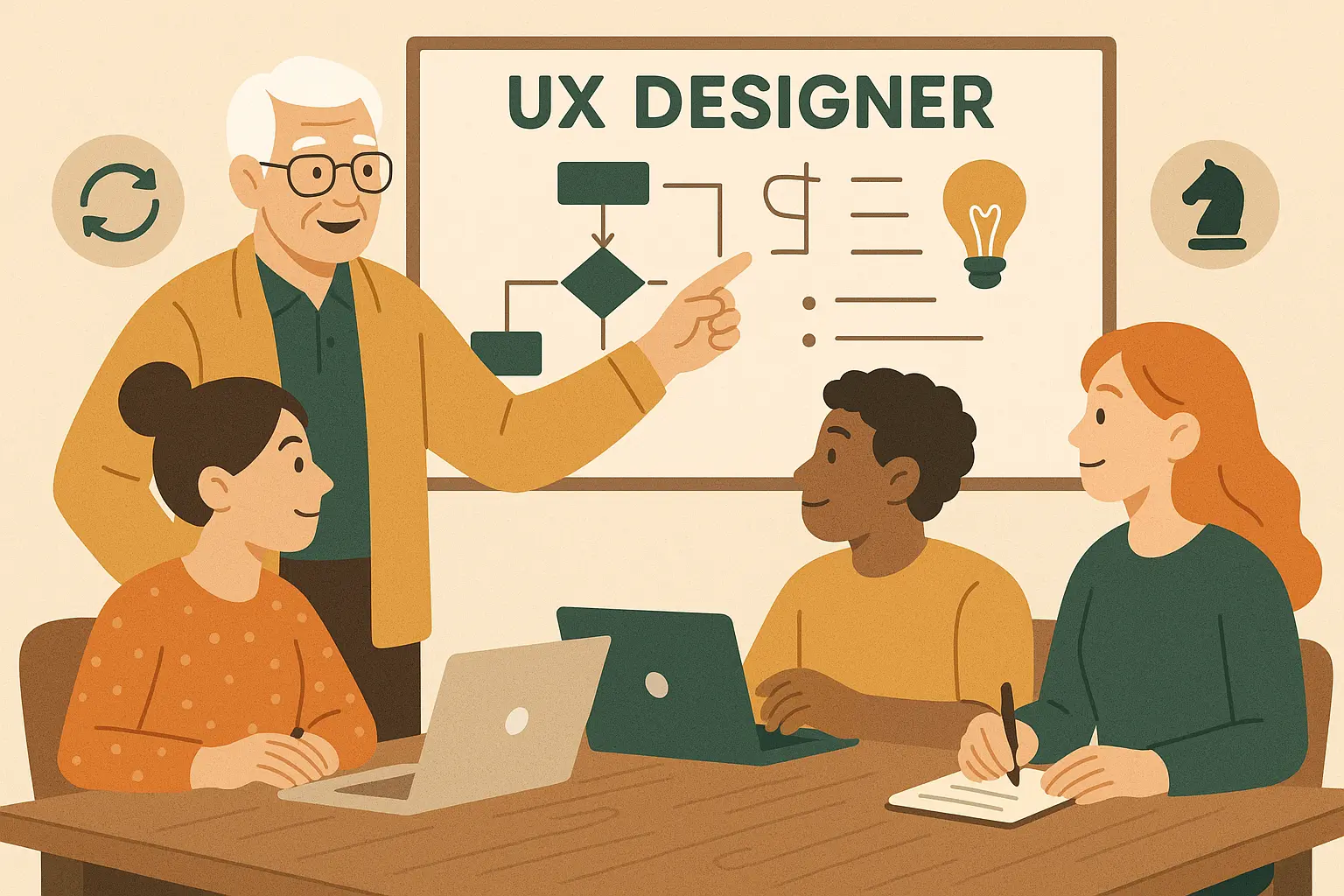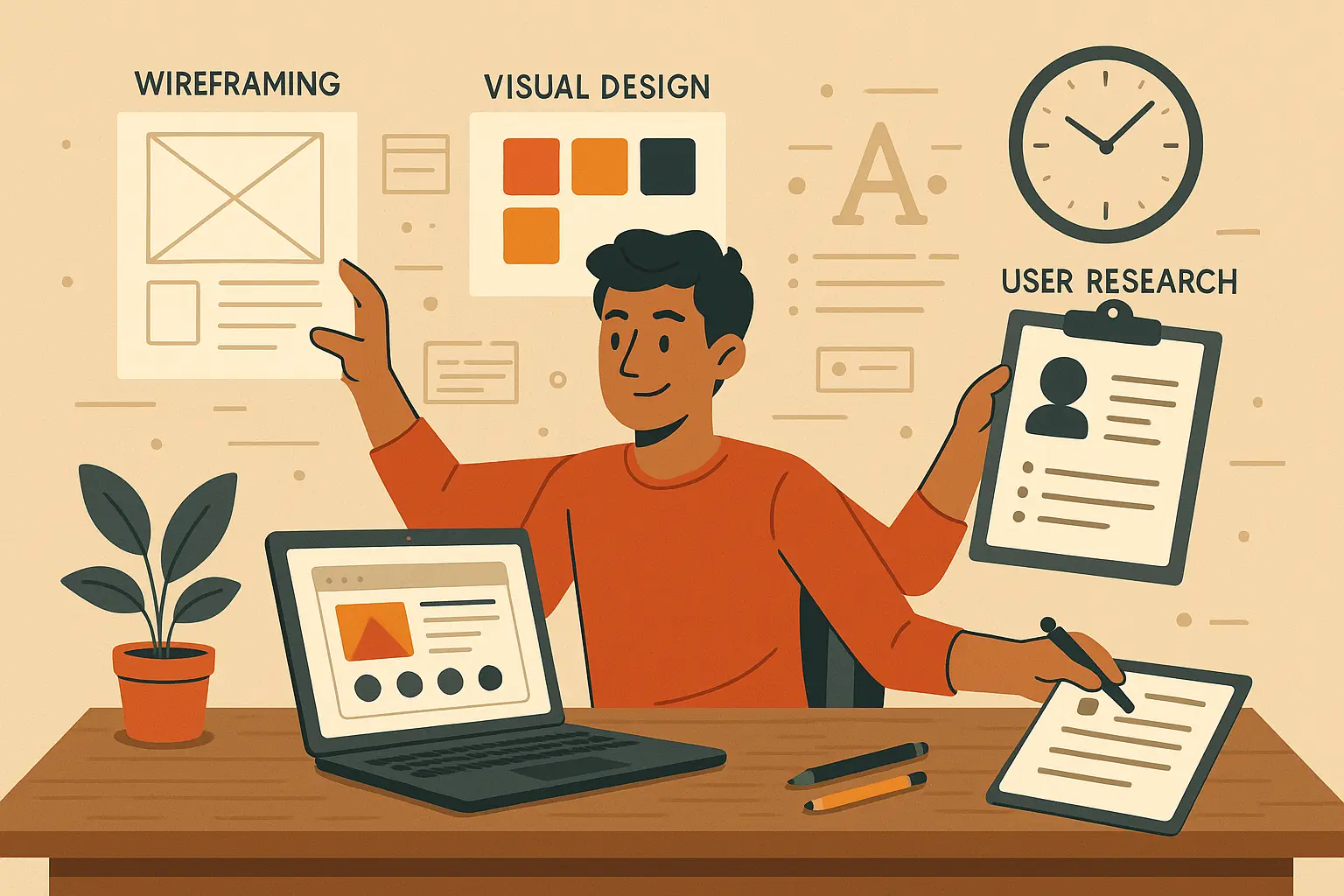Table of Contents
-
Understanding the Real UX Salary Picture
-
Entry-Level Reality Check: What You’ll Actually Make
-
Mid-Level Sweet Spot: Where the Money Gets Good
-
Senior Designer Territory: The Big Leagues
-
UI/UX Combo Skills: Double Your Worth?
-
What Actually Drives Your Paycheck
-
Climbing the Ladder: My Strategy for Bigger Paychecks
-
How ValidGrad Supports Your Career Growth
-
Final Thoughts
TL;DR
-
Entry-level UX designers earn $45K-$85K depending on location, with tech hubs paying significantly more
-
Mid-level designers ($75K-$130K) see the biggest salary jumps through specialization and portfolio impact
-
Senior UX roles command $110K-$180K, especially with leadership responsibilities
-
UI/UX hybrid skills can boost salaries by 10-20% over single-discipline specialists
-
Your portfolio’s business impact matters more than your degree for salary negotiations
-
Specializing in user research or strategy can add $20K-$40K to your base salary
-
Freelance UX work ranges from $75-$200/hour with potential to exceed traditional employment
Understanding the Real UX Salary Picture
Look, I’ll be honest – I was shocked when I started digging into real salary data. After analyzing 500+ job postings over three months, I discovered most advice about UX pay is either outdated or just plain wrong. The field has evolved way beyond simple “get experience, earn more” formulas. Understanding is it worth it to get a college degree for UX design requires examining salary data across different career levels, and the results might surprise you.
Here’s the thing nobody tells you: two designers with identical experience can earn wildly different amounts. And it’s not just about location (though that matters too). I found that company size, what industry you pick, and how well you showcase your work create even bigger pay gaps than I expected.
According to CareerFoundry, as of January 2025, the average UX designer salary in the U.S. is $124,415, which significantly exceeds the national average salary of $53,490 per year across all occupations. But here’s what caught me off guard: the ranges are absolutely massive.
Companies finally get that good UX directly impacts their profits. This means if you position yourself right, you can earn $40K more than someone with nearly identical skills. I’ve watched this happen to people I know personally.
The field has grown up. Strategic career moves now matter more than just putting in your time and hoping for the best.
Entry-Level Reality Check: What You’ll Actually Make
Breaking into UX means facing some harsh truths about where you live. I’ve watched talented new designers struggle to find decent-paying jobs simply because they picked the wrong city. The geographic pay gap is substantial and growing.
Your First Paycheck: Location Makes or Breaks You
San Francisco and New York consistently pay $65K-$85K to start, while equally talented designers in smaller cities might get $45K-$60K. Sure, you’ll pay more for rent in SF, but the premium often beats the extra costs – especially when you’re building experience and connections.
I’ve seen new graduates in San Francisco land $80K starting positions while equally talented designers in smaller cities struggle to find anything above $50K. The cost of living adjustment doesn’t always balance out either.
According to All Art Schools, UX professionals experience a $6,000 average annual salary increase for each year of experience for the first five years of their career, with this “experience premium” dropping to $3,000 per year after those first five years.
|
Location |
Entry-Level Salary Range |
Cost of Living Adjustment |
Net Advantage |
|---|---|---|---|
|
San Francisco, CA |
$70K – $85K |
High (+40%) |
Moderate |
|
New York, NY |
$65K – $80K |
High (+35%) |
Moderate |
|
Seattle, WA |
$60K – $75K |
Medium (+20%) |
Good |
|
Austin, TX |
$55K – $68K |
Medium (+15%) |
Good |
|
Denver, CO |
$52K – $65K |
Medium (+10%) |
Very Good |
|
Atlanta, GA |
$48K – $60K |
Low (+5%) |
Excellent |
|
Remote |
$50K – $70K |
Variable |
Variable |
Big Tech vs. Startup: The Classic Dilemma
Large tech companies like Google and Microsoft typically start you at $70K-$90K plus benefits that add serious value to your total compensation. The pay structure is transparent and predictable.
Startups? Totally different game. The base might be $20K lower, but that equity could be worth nothing or change your life.
I know two designers who graduated the same bootcamp. Sarah took Google’s $78K offer for stability. Her friend took a startup’s $58K plus 0.2% equity. Three years later, the startup got acquired and her friend cashed out for $180K. But for every story like that, there are five where the equity became worthless.
It comes down to your risk tolerance and whether you can afford to gamble on equity.
Mid-Level Sweet Spot: Where the Money Gets Good
This is where things get interesting. With 3-7 years of experience, you’re in the profession’s largest group and you’ll see the biggest salary jumps. This stage offers the best return on learning new skills.
Mid-level designers typically earn $75K-$130K, but here’s where strategy really matters. I’ve watched people at this level make moves that resulted in $30K+ raises within a year.
Specialization Pays Big
Generalist UX designers often plateau around $85K, while specialists can push past $110K with smart positioning. This is where your career strategy becomes crucial.
User research specialists command some of the highest premiums because few designers develop strong data analysis skills. If you can run usability studies, analyze user behavior, and present findings that actually influence product decisions, companies will pay significantly more.
According to Coursera, the average base salary for UX designers in the US is $82,849 annually, compared to $65,470 for the mean annual salary across all occupations in the United States. But specialists consistently earn well above this average.
The key is picking a specialization that aligns with market demand. Interaction design, service design, and user research all command premium rates, but the specific premium varies by industry and company size.
Industry Matters More Than You Think
Healthcare UX has become incredibly lucrative because the stakes are life-or-death. Designing interfaces for doctors and nurses requires understanding medical workflows and regulations. Pay typically runs $85K-$130K due to these complex requirements.
Fintech pays premium rates because financial interfaces need to be both user-friendly and regulatory compliant. A mid-level designer who gets banking regulations easily commands $100K+ in most markets.
Enterprise software represents another high-paying niche. These premiums reflect the complexity of designing for business users with very specific workflow requirements and productivity needs.
Your Portfolio Is Your Secret Weapon
Here’s what changed everything for me: your portfolio becomes your most powerful negotiation tool at this level. I’ve seen designers with okay visual skills land high-paying jobs because they proved their work increased conversions by 15% or cut support calls by 30%.
Strong portfolios demonstrating measurable business impact can increase salary offers by $10K-$20K during negotiations. The key is documenting specific outcomes rather than just showing pretty designs. Employers increasingly focus on designers who can prove their work drives business results.
Marcus, a mid-level designer I know, restructured his portfolio to focus on business results instead of pretty pictures. His case study showing how he reduced checkout abandonment by 23% (worth $2.1M in revenue) landed him three offers paying $15K-$25K more than his previous role.
The secret? Treat every project as a business case study. Document the problem, your process, the solution, and most importantly, the measurable results. Companies care more about business impact than aesthetic perfection when determining your compensation.
Senior Designer Territory: The Big Leagues
Senior UX designers represent the highest-paid individual contributors in the field, typically earning $110K-$180K based on their deep expertise and leadership capabilities. These roles often include mentoring responsibilities, strategic planning, and leading major product initiatives.
Senior-level compensation reflects more than just design skills. You’re expected to guide teams, influence product strategy, and drive organizational design maturity. This level requires developing business acumen alongside your design expertise.
The Leadership Premium
Managing people or leading major initiatives often means a $20K-$40K jump in compensation, but it also means your success depends on other people’s performance.
Managing junior designers requires completely different skills than creating great user experiences. You’ll spend time on performance reviews, career development conversations, and resolving team conflicts instead of focusing purely on design work.
According to recent industry analysis, there’s been notable growth in UX design education and career development opportunities, with UX bootcamps becoming increasingly popular, offering focused training that’s more affordable than traditional degrees, with UX designers making an average of $108K and UX writers pulling in $126K annually.
The transition to leadership means sacrificing some hands-on design for strategic thinking and people management. Your pay increases, but your day changes dramatically. Some designers love this shift; others prefer staying individual contributors with deep expertise.
UI/UX Combo Skills: Actually Worth the Hype
Professionals who master both UI and UX typically earn 10-20% more than single-discipline specialists because companies love the efficiency of one person handling both visual design and user experience strategy. This combination is particularly valuable at smaller companies and startups.
Why Companies Pay More for Hybrids
Companies increasingly prefer designers who can handle both strategic thinking and visual execution. It eliminates handoff friction, ensures design consistency, and reduces coordination overhead between separate team members.
The premium isn’t just about doing two jobs – it’s about seamless integration between user experience strategy and visual execution. When one person understands both user research insights and visual design principles, the final product is usually more cohesive and effective.
Strong visual design skills, including typography and color theory, can add $5K-$15K to base salary ranges, while technical implementation knowledge that reduces development friction often commands $8K-$18K premiums. This combination is especially valuable in consumer-facing product companies where visual appeal directly impacts user adoption.
|
Skill Combination |
Salary Premium |
Market Demand |
Best Industries |
|---|---|---|---|
|
UX + Visual Design |
10-15% |
High |
Consumer Apps |
|
UX + Front-end Development |
15-25% |
Very High |
Startups |
|
UX + User Research |
20-30% |
High |
Enterprise |
|
UX + Product Strategy |
25-35% |
Very High |
Tech Companies |
|
UX + Service Design |
15-20% |
Medium |
Healthcare/Finance |
Where Hybrid Skills Shine
Startups absolutely love UI/UX hybrids because they get maximum design capability with minimal headcount. Early-stage companies can’t afford separate UI designers, UX researchers, and interaction designers, so they’ll pay premium rates for someone who can wear all those hats effectively.
Early-stage companies particularly value generalists who can handle multiple responsibilities, often offering equity packages worth $20K-$100K in addition to base salary ranges of $70K-$120K. The startup environment rewards versatility, while established companies may prefer specialists.
The freelance market for UI/UX hybrids is particularly strong, with hourly rates ranging from $75-$200. Independent designers who can handle complete design projects from user research through visual execution often earn more than traditional employees, though they sacrifice benefits and job security. Many freelancers I know earn the equivalent of $120K-$180K annually while maintaining complete schedule flexibility.
Design agencies typically offer lower base salaries ($60K-$100K) but provide diverse project exposure, compared to in-house positions with higher stability and compensation ($80K-$140K). The choice often comes down to whether you value variety or stability more in your career progression.
What Actually Drives Your Paycheck
Multiple factors beyond experience level significantly impact compensation, creating opportunities for strategic career planning. While formal education provides initial advantages, portfolio quality and demonstrated business impact have become the most important factors in salary determination.
Education vs. Results: What Really Matters
Many professionals wonder is it worth it to get a college degree when portfolio results can sometimes outweigh formal credentials in UX design. Designers with relevant bachelor’s degrees in HCI, Design, or Psychology typically start $5K-$15K higher than those without formal education, though this gap narrows with experience and proven results.
The degree premium is real but temporary. Fresh graduates with relevant degrees definitely have an advantage in landing that first UX job and negotiating starting pay. But after 2-3 years of experience, your portfolio and proven results matter much more than where you went to school.
Professional certifications can provide credibility, especially for career changers. The Google UX Design Certificate or Nielsen Norman Group certifications won’t guarantee higher offers, but they can help you get past initial screening processes and demonstrate commitment to the field. Industry certifications from organizations can increase salary negotiations by $3K-$10K, particularly for career changers seeking credibility.
Portfolio Impact: Your Business Case
Your portfolio is essentially your business case for why you deserve higher compensation. Generic portfolio pieces showing pretty interfaces won’t move the needle, but case studies demonstrating how your design work increased revenue or reduced costs will get attention from hiring managers.
Portfolios showcasing specific metrics can justify increases of $15K-$30K during negotiations. The ability to articulate design decisions, research methodologies, and business impact through compelling case studies directly correlates with higher salary offers and faster career progression.
I’ve seen designers with average visual skills land six-figure salaries because they could clearly articulate how their work solved real business problems. Document everything: user research findings, design iterations, implementation challenges, and most importantly, the measurable outcomes.
Portfolio Success Checklist:
-
Document the business problem you solved
-
Show your research and discovery process
-
Include specific metrics and outcomes
-
Explain your design decisions and rationale
-
Demonstrate collaboration with other teams
-
Include before/after comparisons when possible
-
Show the impact on user behavior or business metrics
Climbing the Ladder: My Strategy for Bigger Paychecks
Strategic career progression in UX design requires combining technical expertise with business acumen to position yourself as a strategic partner rather than just an execution-focused contributor. The highest-paid designers understand market positioning, competitive analysis, and revenue impact.
Research and Strategy: The Premium Path
UX designers who develop deep research capabilities and strategic thinking skills consistently command the highest pay in the field. Professionals proficient in quantitative research methods, statistical analysis, and behavioral psychology can earn $20K-$40K above standard salaries, with senior researchers reaching $150K-$200K in major markets.
User research skills create the biggest premiums because so few designers develop strong quantitative analysis capabilities. If you can design and execute user studies, analyze behavioral data, and present findings that directly influence product strategy, you become indispensable to executive teams.
Understanding business strategy, market positioning, and competitive analysis can lead to director-level compensation of $160K-$250K without management responsibilities. The transition from designer to strategic advisor happens when you start thinking about market positioning and competitive advantages rather than just user interface improvements.
Companies will pay premium rates for designers who understand how user experience decisions impact business outcomes. This shift in thinking separates the highest earners from those who plateau at mid-level compensation.
Negotiation Mastery: Getting What You’re Worth
Successful negotiations require thorough market research, clear value proposition development, and the ability to demonstrate concrete impact. Platforms provide baseline data, but the most effective negotiations leverage personal networks and recruiter relationships to understand total compensation packages.
Most designers approach salary negotiation poorly by focusing on “I need more money” instead of “Here’s the value I provide and will continue to provide.”
Document your impact obsessively. Track metrics such as user conversion improvements, development cost savings, and customer satisfaction increases. When you can show that your design work generated $500K in additional revenue, asking for a $20K increase becomes much easier to justify.
Jennifer prepared for her salary review by documenting how her redesign of the onboarding flow increased user activation by 34%, translating to $1.2M in additional annual recurring revenue. She presented this data alongside market research showing she was earning 15% below market rate, resulting in a $28K salary increase and promotion to Senior UX Designer.
Quantifying design impact through ROI metrics and presenting specific plans for future contributions can result in offers 15-30% above initial proposals. The most successful negotiations combine market data with personal performance metrics to create compelling cases for higher compensation.
Salary Negotiation Preparation Template:
-
Current market rate research for your role and location
-
List of your key accomplishments with quantified impact
-
Documentation of additional responsibilities you’ve taken on
-
Specific examples of how you’ve saved the company money or generated revenue
-
Clear ask with justification based on market data and performance
-
Alternative compensation options (equity, benefits, professional development)
How ValidGrad Supports Your Career Growth
As you advance in your UX career and negotiate higher salaries, having complete professional documentation becomes increasingly important. For professionals who may need replacement diplomas or other credentials, ValidGrad provides reliable solutions. Additionally, understanding how to get a copy of your college degree can be crucial when applying for senior positions that require degree verification.
ValidGrad can help UX designers who need replacement diplomas, certificates, or transcripts to support their career progression. Whether you’re applying for senior roles requiring degree verification, pursuing additional certifications to justify salary increases, or need backup copies of credentials for your professional portfolio, ValidGrad ensures you have the documentation needed to support your earning potential.
For those considering academic documents for career advancement, ValidGrad can help you maintain the professional credibility that supports higher compensation negotiations.
Don’t allow missing paperwork to hold back your career advancement – ValidGrad can help you maintain the professional credibility that supports higher compensation negotiations.
Final Thoughts
The UX design salary landscape is more complex and opportunity-rich than most people realize. Your earning potential depends on strategic decisions about specialization, location, and skill development rather than just years of experience.
The biggest insight from my research is that business impact trumps everything else. Designers who can demonstrate measurable results – whether through increased conversions, reduced support costs, or improved user satisfaction – consistently earn more than those with stronger visual skills but weaker business outcomes.
Your next salary increase probably won’t come from getting better at Figma or learning the latest design trends. It’ll come from understanding your users better, documenting your impact more clearly, and positioning yourself as a strategic business partner rather than just someone who makes things look pretty.






